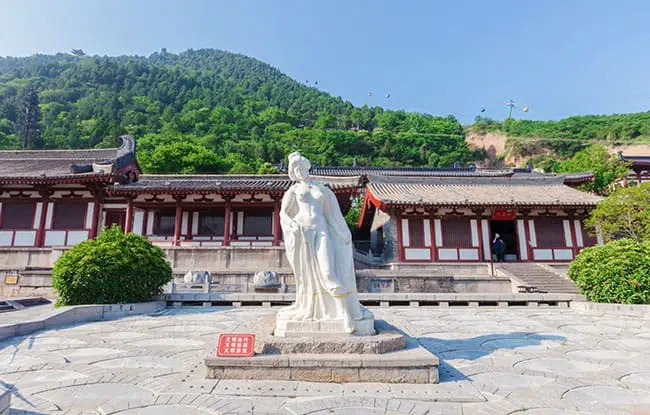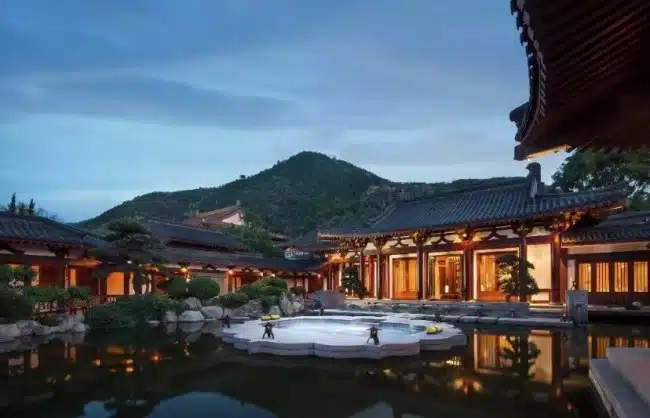Huaqing Hot Springs and the Love Story Between Emperor Xuanzong and Lady Yang
Written by Clementine |
Located at the northern foot of Mt. Lishan in Lindong County of Shaanxi Province, 30 kilometers from Xian, near the Terracotta Army, the Huaqing Hot Springs is a state place of interest as well as a national geological Forest Park. Also known as Huaqing Palace or Huaqing Pool, it is one of the most famous hot spring pools in Xi’an, highlighting ancient palace complexes and scenic natural views.
Huaqing Hot Springs, together with the Summer Palace, Yuanmingyuan and Chengde Summer Resort, is known as the four great imperial gardens in China. The rulers of the Zhou, Qin, Han, Sui, and Tang dynasties all built different palaces here. It is famous at home and abroad for its timeless hot spring resources, the historical allusions of the feudal princes in the Beacon Fire drama, the love story of Tang Ming Emperor and Yang Guifei, and the place where the “Xi ‘an Incident” took place.
Content Preview
- Fast Facts of the Huaqing Hot Springs
- History of Huaqing Hot Springs
- Love Story Between Emperor Xuanzong & Yang Yuhuan
- What to See and Do at Huaqing Hot Springs
- Best Time to Visit Huaqing Hot Spring
- Attractions Nearby
Fast Facts of the Huaqing Hot Springs
- Location: 38 Huaqing Road, Lintong District, Xi’an City, Shaanxi Province, China; at the northern foot of Li Mountain
- Type: Natural beauty, ancient architecture, cultural relics.
- Opening Hours:7:00-19:00 in peak season (Mar. – Nov.); 7:30-18:00 in low season (Dec. – Feb.).
- Ticket Price: From March to November, the price is 150 yuan/person; From December to the end of February, the price is 120 yuan/person
- Best Seasons:March to October
- Time Needed:around 3 hours
- Best for: Culture and history lovers

History of Huaqing Hot Springs
According to the record, as early as the Dynasties of Zhou, Qin, Han, Sui, and Tang, a temporary imperial abode was constructed here. In the 6th year of Emperor Xuanzong’s Reign in the Tang Dynasty(747) it was expanded on a massive scale by turning the hot springs into bathing pools, ringing the Mount with palace buildings, which were to be protected by an outer circular defensive wall and renamed it Huaqing Palace.
As the palace was built upon the hot springs, it was also called Hot Spring Pools. In 756, it was reduced to ruins by the flames of war. Most of the existing buildings were constructed in the Qing Dynasty and after the liberation of China.
Love Story Between Emperor Xuanzong & Yang Yuhuan
The tragic and woeful love story between Emperor Xuanzong of the Tang Dynasty (reigned 712–756) and his beloved Yang Yuhuan (719–756) remains one of China’s most enduring and famous love stories, and it’s preserved forever in Bai Juyi’s famous poem The Song of Everlasting Sorrow. This poignant romance unfolded and also fallen during the golden age of the Tang Dynasty. The witness of their poignant love, the Huaqing Hot Springs, is still silently lying at the foot of Mount Lishan near Xi’an.
Falling in Love
At the age of 56, Xuanzong first met the young and beautiful Yang Yuhuan in the Huaqing Hot Spring. He fell in love with her almost at the first glance, feeling that she’s the only one who could fill the void in his heart left by the loss of his beloved Consort Wu. He soon brought her into the imperial palace as his favored concubine, with a willing to give her all the best things in the world. His affection for her was so profound that he even had the Crabapple Pool built exclusively for her to bathe in.
The Inseparable Couple
They went everywhere together in the days and nights. Their time was filled with lavish banquets in the Jade Tower, moonlit nights behind gauzy lotus-print curtains, and joyful dances in the Palace of Eternal Youth. Over time, Yang Yuhuan had also grown equally devoted to the emperor, and their love flourished. And the Huaqing Hot Spring, where they first saw each other, had become a place that only belonged to them, just two of them.
Farewell to the Lover
However, their happiness was short-lived. In 755, a devastating rebellion broke out, led by An Lushan—Yang’s adopted son—and fueled by a political struggle involving Yang’s brother. As rebel forces closed in on the capital, Emperor Xuanzong and Yang Yuhuan had to flee together to the Mawei Slope. Fate was unbearably cruel to Yang, a fragile and innocent woman. Amid the chaos, royal guards blamed Yang and her family for the uprising and demanded her execution. Heartbroken and powerless, the emperor was forced to comply. The death of Yang Yuhuan left the emperor shattered and drown in grief, and he eventually abdicated the throne.
Reunion in the Fairyland
Even after safely returning to Chang’an, Xuanzong still remained haunted by Yang’s memory. Grief-stricken and heart-broken, the once-powerful ruler became a shadow of his former self. He could not help missing her, and for years, all he dreamt for was a reunion—imagining their souls meeting in the palace of the moon, where they could hold each other’s hands, shed tears, and relive their love once again.
A Living Performance about Their Love Story is Staged in Huaqing Pool
This heartrending tale is now brought to life in the large-scale, open-air historical drama The Song of Everlasting Sorrow. Staged at, Huaqing Palace, the very site where the romance first began, the breathtaking show starts with a prologue and continuous with nine acts divided into four poignant chapters: Falling in Love, The Inseparable Couple, Farewell to the Lover, and Reunion in the Fairyland. With Mount Lishan and Nine-Dragon Lake as the backdrop, audiences can watch the performance combines majestic architecture—pavilions, palaces, willow trees, and tranquil waters—with incredible visual effects: imperial grandeur, rolling mists, sparkling stars, and fiery spectacles that transport the audience back to the splendor of the Tang Dynasty.
What to See and Do at Huaqing Hot Springs
Huaqing Pools is fascinating for its exquisite and picturesque scenery characterized by pink peach blossoms, green willows, dense foliage, beautiful pavilions and terraces, magnificent halls, rolling towers, etc. Jiulong(Nine Dragons) Lake is crystal clear and mirrors the pavilions and towers. There are four hot springs in the Huaqing Pool. The water is so clear that you can see down to the bottom. See below the top things to do on your trip to the Huaqing Hot Springs.

Visit the Museum of Imperial Hot Springs
This museum is where the original royal hot springs of Tang Dynasty are located. Here you can witness the original Star Pool and the Lotus Pool which was used by Emperor Zuanzong and his concubine Yang Guifei. Also, the over 3,000 pieces of architectural materials here will introduce you to the architectural features and culture of the Tang Dynasty.
See the Historical Site of Xi’an Incident
On December 12, 1936, two patriotic generals of the Nationalist Party kidnapped their leader Chiang Kai-shek at the Huaqing Palace in Xian to force him to stop the civil war and resist the invasion of Japanese. This incident was knwon as Xian Incident or Double 12th Incident which drew international attention and marked a turning point in the Chinese resistance against Japan. When visiting the Huaqing Hot Springs, visitors can also make a visit to the museum of Xi’an Incident to see the historical relics, photos, and documents related to this incident.
Admire the Nine Dragon Lake & Pear Garden
The Nine Dragon Lake is a man-made lake built in 1959, covering an area of about 5,300 square meters. The lake is divided into two parts by the Nine Dragon Bridge and reflects the distinctive features of the northern royal gardens. The upper part features modern fountains, while the lower part invites visitors with a large stone dragon boat and the sculpture of Yang Yuhuan.
The Pear Garden is the imperial theater in the Tang Dynasty. It is the place where Emperor Xuanzong and Yang Yuhuan once enjoyed music and dance performance. The current museum of Pear Garden is restored on the original site, housing many artifacts unearthed from the former Pear Garden and 15 murals depicting musical and dance performances.
Bath in the Huaqing Hot Spring
There are more than 2,700 known hot springs in China, and the unique Huaqing hot spring Pool is known as “the first royal spring in the world” for its water quality and touching stories. Huaqingchi hot spring was formed two to three million years ago and was used by the ancestors of Jiangzhai 6,000 years ago. The water temperature of the hot spring is maintained at 43℃ all year round, and the water contains more than 10 kinds of minerals such as silica and fluoride ions, which has obvious curative effect on diseases such as rheumatism and arthritis.

Watch the Dance Drama of the Song of Everlasting Sorrow
The Song of Everlasting Sorrow show is a large-scale real scene drama based on the poem by Baijuyi, depicting how the Emperor Xuanzong and Yang Yuhuan met, fell in love, and their sad end due to the rebellion. With the Li Mountain as its background, it will reward you with a stunning visual spectacle, enchanting dance, and traditional Tang costumes.
Drama of the Song of Everlasting Sorrow |
|
Schedule |
From April to October |
Show Time |
First session: 20:10-21:20
Second session: 21:40-22:50 |
Price |
VIP Area A: 988 yuan/person; VIP Area B: 888 yuan/person; VIP Area C: 588 yuan/person
Central Area: 298 yuan/person East and West Area A: 268 yuan/person; East and West Area B: 238 yuan/person |
Best Time to Visit Huaqing Hot Spring
Xi’an has a warm temperate semi-humid continental monsoon climate. Therefore, spring season from March to May and autumn season from September to November are the best time to visit Huaqing Hot Spring in Xi ‘an.
How to Get to Huaqing Hot Spring Pool
By bus:
From Xi ‘an Railway Station (East Square), take bus No. 914, 915, You 5 (306) and get off at Huaqingchi Station.
From Lintong District, you can take No. 101 tourist bus.
By subway:
From Xian city center, take Metro Line 9, and get off at Huaqingchi Station, then walk to the scenic spot in 3 minutes.
Attractions Nearby
- Terracotta Warriors and Horses: One of the top reasons for people travel to Xian. Marvel at over 8,000 life-size clay soldiers and horses that were burried with Emperor Qin Shi Huang.
- Li Mountain: Standing at a height of about 1,256 meters, the mountain had served as royal garden since the Zhou period. It is known for the stunning natural scenery, many ancient temples, and the earliest military observation tower in China.







